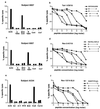The HIV-1 regulatory proteins Tat and Rev are frequently targeted by cytotoxic T lymphocytes derived from HIV-1-infected individuals
- PMID: 11172028
- PMCID: PMC29334
- DOI: 10.1073/pnas.98.4.1781
The HIV-1 regulatory proteins Tat and Rev are frequently targeted by cytotoxic T lymphocytes derived from HIV-1-infected individuals
Abstract
The HIV-1 regulatory proteins Rev and Tat are expressed early in the virus life cycle and thus may be important targets for the immune control of HIV-1-infection and for effective vaccines. However, the extent to which these proteins are targeted in natural HIV-1 infection as well as precise epitopes targeted by human cytotoxic T lymphocytes (CTL) remain to be defined. In the present study, 57 HIV-1-infected individuals were screened for responses against Tat and Rev by using overlapping peptides spanning the entire Tat and Rev proteins. CD8+ T cell responses against Tat and Rev were found in up to 19 and 37% of HIV-1-infected individuals, respectively, indicating that these regulatory proteins are important targets for HIV-1-specific CTL. Despite the small size of these proteins, multiple CTL epitopes were identified in each. These data indicate that Tat and Rev are frequently targeted by CTL in natural HIV-1 infection and may be important targets for HIV vaccines.
Figures




References
Publication types
MeSH terms
Substances
Grants and funding
LinkOut - more resources
Full Text Sources
Other Literature Sources
Medical
Molecular Biology Databases
Research Materials

